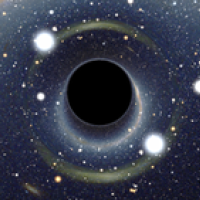
Building a theory of quantum gravity
The Isaac Newton Institute for Mathematical Sciences (INI) in Cambridge hosted a research programme on one of the most pressing problems in modern physics: to build a theory that can explain all the fundamental forces and particles of nature in one unifying mathematical framework. Such a theory of quantum gravity would combine two hugely successful frameworks on theoretical physics, which have so far eluded unification: quantum physics and Einstein's theory of gravity.
The Black holes: bridges between number theory and holographic quantum information programme focusses on black holes, which play a hugely important part in this area, on something called the holographic principle, and on surprising connections to pure mathematics. This collection of articles explores the central concepts involved and gives you a gist of the cutting edge research covered by the INI programme.
From steam engines to the limits of physics — Come on a fantastic journey from some of our oldest ideas about physics to the biggest mystery of the modern age – quantum gravity!
Entropy: From fridge magnets to black holes — Entropy is a concept that lies at the heart of modern physics. It brings together physics at every scale, from your cup of tea to black holes.
Quantum gravity in the can: The holographic principle — It might sound like something from science fiction, but the holographic principle might help us answer the biggest problem in modern physics.
String theory: A promise from physics — Mathematics is an indispensable tool in physics, but can physics solve problem in maths? Find out more in this article.
String theory: Convincing mathematics — Find out how a theory from physics has provided tools for solving long-standing problems in number theory. And in turn how number theory helps solve the mystery of black holes.
Tying together black holes, quantum gravity and number theory — "The 20th century was the interaction of geometry and physics, and the 21st century is the interaction of number theory with physics." Find out why in our first conversation with Yang-Hui He in a podcast that accompanies the previous two articles.
The murmuration conjecture: finding new maths with AI — An exciting new conjecture, that came about due to both artificial and human intelligence, reveals patterns in the prime numbers that look like flocks of birds.
You can also listen to this interview in our second podcast with Yang-Hui He.
Background reading
Maths in a minute: Einstein's general theory of relativity — Here's a brief introduction to Einstein's theory, which revolutionised our understanding of the force of gravity.
Maths in a minute: Black holes — The general theory of relativity suggests that the Universe contains regions from which nothing, not even light, can escape. And although a contentious idea at first, these so-called black holes have since been discovered. Here's a brief introduction.
A ridiculously short introduction to some very basic quantum mechanics — This article gives a short introduction to the strange theory of quantum mechanics, which underlies our understanding of the smallest constituents of the world we live in.
Physics in a minute: What's the problem with quantum gravity? — Here's an extremely brief look at why the general theory of relativity and quantum mechanics don't go together.
String theory: From Newton to Einstein and beyond — This article explores string theory, a contested contender for a quantum theory of gravity.
The holographic principle — This article provides an in-depth look at a curious theory that seems to suggest the world is a hologram.
Maths in a minute: Statistical mechanics — Statistical mechanics bridges the gap between the microscopic and the macroscopic.
Maths in a minute: Thermodynamics — Thermodynamics, the theory of heat and heat flow, is highly relevant to our understanding of black holes.
Maths in a minute: The information paradox — The information paradox is an unresolved puzzle in theoretical physics which greatly intrigued the famous physicist Stephen Hawking. It's about black holes and what happens to information that falls into them.
This content is now part of our collaboration with the Isaac Newton Institute for Mathematical Sciences (INI) – you can find all the content from the collaboration here.
The INI is an international research centre and our neighbour here on the University of Cambridge's maths campus. It attracts leading mathematical scientists from all over the world, and is open to all. Visit www.newton.ac.uk to find out more.
